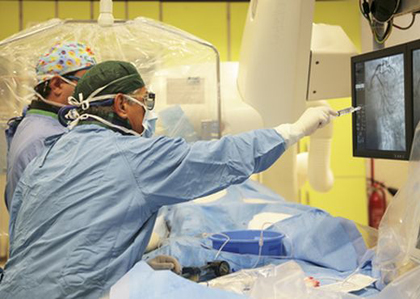Courtesy of Dr. Carlos Fava.

A total of 354 carotid atherosclerotic stenoses in 328 consecutive patients who underwent stenting were retrospectively analyzed. Plaque protrusion was defined as plaque inside the stent lumen after dilatation, as observed through both digital subtraction angiography and IVUS. The incidence of ischemic stroke within 30 post-operative days and the presence of ischemic lesions as observed through diffusion-weighted nuclear magnetic resonance imaging performed within 48 post-operative hours were analyzed.
Plaque protrusion was observed in 9 patients (2.6%). The mean age was 73 years old (most patients were male) and 80% of patients presented carotid artery lesions. No difference was observed regarding protection system or stent type used. All patients received dual antiplatelet therapy.
The presence of plaque protrusion was significantly higher in patients who received open-cell stents. At 30 days, the incidence of stroke was higher in the plaque protrusion patient group (66.6% vs.1.1%; p = < 0.0001). At 48 hours, lesions were observed through diffusion-weighted imaging in more patients (8) in this group than in those who received open-cell stents and presented unstable plaque.
Plaque protrusion was strongly associated with peri-procedural stroke.
Conclusion
The incidence of plaque protrusion in carotid artery stenting was 2.6% and it was associated with a high risk of ischemic complications. These findings indicate the necessity of appropriate device selection to avoid plaque protrusion.
Editorial Comment
While operator expertise has lowered the rates of adverse events, current technology must be improved in order to avoid plaque protrusion, which is associated with an extremely high rate of stroke.
This undesired event does not only affect the patient: it alters his/her family and social relationships, and it creates high costs for health systems.
Courtesy of Dr. Carlos Fava.
Original title: Carotid Artery Stenting. Investigation of Plaque Protrusion Incidence and Prognosis.
Reference: Masashi Kotsugi, et al. J Am Coll Cardiol Intv 2017;10:824-31.
Subscribe to our weekly newsletter
Get the latest scientific articles on interventional cardiology
We are interested in your opinion. Please, leave your comments, thoughts, questions, etc., below. They will be most welcome.




